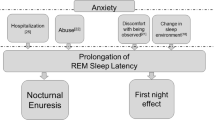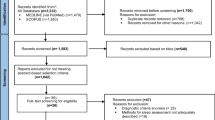Abstract
Background
Children with nocturnal enuresis (NE) have been found to have sleep fragmentation and a high incidence of periodic limb movements in sleep (PLMS). This study explored the association of monosymptomatic NE and polyuria in relation to fluid intake, bladder volume, number of wet nights, and number of nights with polyuria to the frequency of PLMS and cortical arousals during sleep.
Materials and methods
Thirty children with monosymptomatic NE and polyuria were enrolled in the study. Enuretic parameters were determined by diaries, forced drinking, uroflow, and ultrasound examination. All subjects participated in one polysomnographic study. The number of cortical arousals and PLMS were compared with those recorded in a former pilot study which included only children with refractory NE.
Results
Of the 30 children who participated in the study, the mean age was 10.43 ± 3.08 (range 6–16) years, and 23 were boys. The PLMS index was positively associated with the arousal index and the awakening index (p < 0.001). No significant association between the sleep and the enuretic parameters was found. Children with refractory NE showed a significantly higher PLMS index (p < 0.001).
Conclusions
We found that PLMS and cortical arousals in sleep were increased in children with monosymptomatic NE and polyuria, without a significant association with the enuretic parameters. These observations suggest the presence of a comorbid mechanism driven by a common, independent pacemaker. We hypothesize the autonomic system, its sympathetic branch, and the dopaminergic system as candidates for this pacemaker.
Similar content being viewed by others
References
Butler RJ (2004) Childhood nocturnal enuresis: developing a conceptual framework. Clin Psych Rev 24:909–931
Djurhuus JC, Matthiesen TB, Rittig S (1999) Similarities and dissimilarities between nocturnal enuresis in childhood and nocturia in adults. BJU Int 84:9–12
Yeung CK, Sit FK, To LK, Chiu HN, Sihoe JD, Lee E, Wong C (2002) Reduction in nocturnal functional bladder capacity is a common factor in the pathogenesis of refractory nocturnal enuresis. BJU Int 90:302–307
Dijk DJ, Czeisler CA (1995) Contribution of the circadian pacemaker and the sleep homeostat to sleep propensity, sleep structure, electroencephalographic slow waves, and sleep spindle activity in humans. J Neurosc 15:3526–3538
De Guchtenaere A, Vande Walle C, Van Sintjan P, Raes A, Donckerwolcke R, Van Laecke E, Hoebeke P, Vande Walle J (2007) Nocturnal polyuria is related to absent circadian rhythm of glomerular filtration rate. J Urol 178:2626–2629
Negoro H, Kanematsu A, Yoshimura K, Ogawa O (2013) Chronobiology of micturition: putative role of the circadian clock. J Urol 190:843–849
Rittig S, Schaumburg HL, Siggaard C, Schmidt F, Djurhuus JC (2008) The circadian defect in plasma vasopressin and urine output is related to desmopressin response and enuresis status in children with nocturnal enuresis. J Urol 179:2389–2395
Bader G, Neveus T, Kruse S, Sillèn U (2002) Sleep of primary enuretic children and controls. Sleep 25:579–583
Chandra M, Saharia R, Hill V, Shi Q (2004) Prevalence of diurnal voidings symptoms and difficult arousal from sleep in children with nocturnal enuresis. J Urol 172:311–316
Neveus T, Stenberg A, Lackgren G, Tuvemo T, Hetta J (1999) Sleep of children with enuresis: a polysomnographic study. Pediatrics 103:1193–1197
Wolfish NM, Pivik RT, Busby KA (1997) Elevated sleep arousal thresholds in enuretic boys: clinical implications. Acta Paediatr 86:381–384
Cohen-Zrubavel V, Kushnir B, Kushnir J, Sadeh A (2011) Sleep and sleepiness in children with nocturnal enuresis. Sleep 34:191–194
Dhondt K, Raes A, Hoebeke P, Van Laecke E, Van Herzeele C, Vande Walle J (2009) Abnormal sleep architecture and refractory nocturnal enuresis. J Urol 182:1961–1965
Yeung CK, Diao M, Sreedhar B (2008) Cortical arousal in children with severe enuresis. N Engl J Med 358:2414–2415
Dhondt K, Baert E, Van Herzeele C, Raes A, Groen LA, Hoebeke P, Vande Walle J (2014) Sleep fragmentation and increased periodic limb movements are more common in children with NE. Acta Paediatr 103:268–272
Mahler B, Kamperis K, Schroeder M, Frǿkǽr J, Djurhuus RC, Rittig S (2012) Sleep deprivation induces excess diuresis and natriuresis in healthy children. Am J Physiol renal Physiol 15:236–243
Austin P, Bauer SB, Bower W, Chase J, Franco I, Hoebeke P, Rittig S, Vande Walle J, Von Gontard A, Wright A, Yang SS, Nevéus T (2014) The standardization of terminology of lower urinary tract function in children and adolescents: update report from the standardization committee of the international children’s continence society. J Urol. 191:1963–1965
Hjalmas K (1988) Urodynamics in normal infants and children. Scand J Urol Nephrol 114:20–27
Hollingshead AB (1971) Commentary on “ the indiscriminate state of social class environment. Social Forces 49:563–567
Iber C, Ancoli-Israel SC (2013) The AASM manural for the scoring of sleep and associated events. Rules, terminology and technical specifications. West-Brook Corporate Center, Westchester
Kemlink D, Pretl M, Sonka K, Nevsimalova S (2008) A comparison of polysomnographic and actigraphic evaluation of periodic limb movements in sleep. Neurol Res 30:234–238
Jambhekar SK, Com G, Jones E, Jackson R, Castro MM, Knight F, Carroll JL, Griebel ML (2011) Periodic limb movements during sleep in children with narcolepsy. J Clin Sleep Med 7:597–601
Montplaisir J, Michaud M, Denesle R, Gosselin A (2000) Periodic leg movements are not more prevalent in insomnia or hypersomnia but are specifically associated with sleep disorders involving a dopaminergic impairment. Sleep Med 1:163–167
Carrier J, Frenette S, Monplaisir J, Paquet J, Drapeau C, Morettini J (2005) Effects of periodic leg movements during sleep in middle-aged subjects without sleep complaints. Mov Dis 20:1127–1132
Pennestri MH, Whittom S, Adam B, Petit D, Carrier J, Montplaisir J (2006) PLMS and PLMW in healthy subjects as a function of age: prevalence and interval distribution. Sleep 29:1183–1187
Sforza E, Nicolas A, Lavigne G, Gosselin A, Petit D, Montplaisir J (1999) EEG and cardiac activation during periodic leg movements in sleep: support for a hierarchy of arousal responses. Neurology 52:786–791
Manconi M, Ferri R, Zucconi M, Clemens S, Rundo F, Oldani A, Ferini- Strambi L (2011) Effects of acute dopamine-agonist treatment in restless legs syndrome on heart rate variability during sleep. Sleep Med 12:47–55
Clemens S, Rye D, Hochman S (2006) Restless legs syndrome: revisiting the dopamine hypothesis from the spinal cord perspective. Neurology 67:125–130
Hussain TF, Lokhandwala M (2003) Renal dopamine receptors and hypertension. Exp Biol Med 228:134–142
Wing YK, Zhang J, Ho CK, Au CT, Li AM (2010) Periodic limb movement during sleep is associated with nocturnal hypertension in children. Sleep 33:759–765
Kruse A, Mahler B, Rittig S, Djurhuus JC (2009) Increased nocturnal blood pressure in enuretic children with polyuria. J Urol 182:1954–1960
Yoshimura N, Miyazato M, Kitta T, Yoshikawa S (2014) Central nervous targets for the treatment of bladder dysfunction. Neurourol Urodyn 33:59–66
Nakagawa H, Okumura N (2010) Coordinated regulation of circadian rhythms and homeostasis by the suprachiasmatic nucleus. Proc Jpn Acad Ser B Phys Biol Sci 86:391-409
Arai M (2011) Increased plasma arginine vasopressin levels in dopamine agonist-treated Parkinson’s disease patients. Neuro Endocrinol Lett 32:39–43
Picchietti MA, Picchietti DL, England SJ, Walters AS, Couvadelli BV, Lewin DS, Hening W (2009) Children show individual night-to-night variability of periodic limb movements in sleep. Sleep 32:530–535
Author information
Authors and Affiliations
Corresponding author
Rights and permissions
About this article
Cite this article
Dhondt, K., Van Herzeele, C., Roels, S.P. et al. Sleep fragmentation and periodic limb movements in children with monosymptomatic nocturnal enuresis and polyuria. Pediatr Nephrol 30, 1157–1162 (2015). https://doi.org/10.1007/s00467-015-3044-3
Received:
Revised:
Accepted:
Published:
Issue Date:
DOI: https://doi.org/10.1007/s00467-015-3044-3




